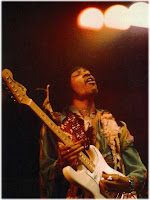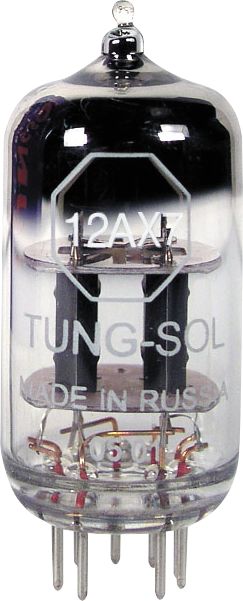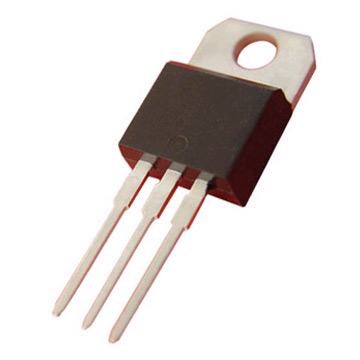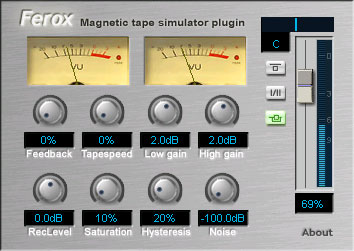Distortion Explained Part 1
 It is hard to think about the
sound of an electric guitar without thinking about distortion. There was a time when
electric guitars were always clean. Hard to imagine now.
It is hard to think about the
sound of an electric guitar without thinking about distortion. There was a time when
electric guitars were always clean. Hard to imagine now.
Traditionally distortion was an unwanted
feature in amplifier design. Distortion only occurred when the amp was
damaged or overdriven. Possibly the first intentional use of distortion
was in the 1951 recording of “Rocket 88″ By Ike Turner and the Kings of
rhythm.
Chuck Berry liked to use small tube amps
that were easy to overdrive for his trademark sound and other guitarists
would intentionally damage their speakers by poking holes in them,
causing them to distort.
Leo Fender then started designing amps
with some light compression and slight overdrive and Jim Marshall
started to design the first amps with significant overdrive. That sound
caught on quickly and by the time Jimi Hendrix was using Roger Mayer’s
effects pedals, distortion would forever be associated with the electric
guitar.
Not just for guitars
When you're recording and mixing, you can use a bit of distortion to give any sound more edge, grit, energy and excitement. Drums, vocals, bass, samples - they can all benefit from a touch of distortion at times. Understanding the different ways distortion can be created and how they sound can help you get better sounds and make better recordings.
Not just for guitars
When you're recording and mixing, you can use a bit of distortion to give any sound more edge, grit, energy and excitement. Drums, vocals, bass, samples - they can all benefit from a touch of distortion at times. Understanding the different ways distortion can be created and how they sound can help you get better sounds and make better recordings.
So What Is Distortion?
The word distortion means any change in
the amplified waveform from the input signal. In the context of musical
distortion this means clipping the peaks off the waveform. Because both
valves and transistors behave linearly within a certain voltage region,
distortion circuits are finely tuned so that the average signal peak
just barely pushes the circuit into the clipping region, resulting in
the softest clip and the least harsh distortion. Because of this, as the
guitar strings are plucked harder, the amount of distortion and the
resulting volume both increase, and lighter plucking cleans-up the
sound. Distortion adds harmonics and makes a sound more exciting.
Amp Distortion
Valve Overdrive
 Before
transistors, the traditional way to create distortion was with vacuum
valves also known as vacuum tubes. A vacuum tube has a maximum input
voltage determined by its bias and a minimum input voltage determined by
its supply voltage. When any part of the input waveform approaches
these limits, the valve’s amplification becomes less linear, meaning
that smaller voltages get amplified more than the large ones. This
causes the peaks of the output waveform to be compressed, resulting in a
waveform that looks “squashed”. This is known as “soft clipping”, and
generates even-order harmonics that add to the warmth and richness of
the guitar’s tone. If the valve is driven harder, the compression
becomes more extreme and the peaks of the waveforms are clipped. This
adds additional odd-order harmonics, creating a “dirty” or “gritty”
tone.
Before
transistors, the traditional way to create distortion was with vacuum
valves also known as vacuum tubes. A vacuum tube has a maximum input
voltage determined by its bias and a minimum input voltage determined by
its supply voltage. When any part of the input waveform approaches
these limits, the valve’s amplification becomes less linear, meaning
that smaller voltages get amplified more than the large ones. This
causes the peaks of the output waveform to be compressed, resulting in a
waveform that looks “squashed”. This is known as “soft clipping”, and
generates even-order harmonics that add to the warmth and richness of
the guitar’s tone. If the valve is driven harder, the compression
becomes more extreme and the peaks of the waveforms are clipped. This
adds additional odd-order harmonics, creating a “dirty” or “gritty”
tone.Transistor Clipping
 Transistor
clipping stages, on the other hand, behave far more linearly within
their operating regions, and faithfully amplify the instrument’s signal
until the input voltage falls outside its operating region, at which
point the signal is clipped without compression, this “hard clipping”
or limiting. This type of distortion tends to produce more odd-order
harmonics. Electronically, this is usually achieved by either amplifying
the signal to a point where it must be clipped to the supply rails, or
by clipping the signal across diodes. Many solid state distortion
devices attempt to emulate the sound of overdriven vacuum valves.
Transistor
clipping stages, on the other hand, behave far more linearly within
their operating regions, and faithfully amplify the instrument’s signal
until the input voltage falls outside its operating region, at which
point the signal is clipped without compression, this “hard clipping”
or limiting. This type of distortion tends to produce more odd-order
harmonics. Electronically, this is usually achieved by either amplifying
the signal to a point where it must be clipped to the supply rails, or
by clipping the signal across diodes. Many solid state distortion
devices attempt to emulate the sound of overdriven vacuum valves.
So that is basically how Tube and Solid
state amps create distortion. Let’s talk about some different types of
distortion sounds as found in effects pedals.
Tape Saturation
 Another way to create distortion is with magnetic tape. Magnetic tape has a natural compression and
saturation when you send it a really hot signal. Even today, many
artists of all genres prefer analog tape’s “musical”, “natural” and
especially “warm” sound. Due to harmonic distortion, bass can thicken
up, creating the illusion of a fuller-sounding mix. In addition, high
end can be slightly compressed, which is more natural to the human ear.
It is common for artists to record to digital and re-record the tracks
to analog reels for this effect of “natural” sound. While recording to
analog tape is likely out of the home studio budget, there are tape
saturation plugins that you can use while mixing that simulate the
effect quite well. Most tape saturation effects are modeling both the magnetic tape and overloading of electronics.
Another way to create distortion is with magnetic tape. Magnetic tape has a natural compression and
saturation when you send it a really hot signal. Even today, many
artists of all genres prefer analog tape’s “musical”, “natural” and
especially “warm” sound. Due to harmonic distortion, bass can thicken
up, creating the illusion of a fuller-sounding mix. In addition, high
end can be slightly compressed, which is more natural to the human ear.
It is common for artists to record to digital and re-record the tracks
to analog reels for this effect of “natural” sound. While recording to
analog tape is likely out of the home studio budget, there are tape
saturation plugins that you can use while mixing that simulate the
effect quite well. Most tape saturation effects are modeling both the magnetic tape and overloading of electronics.Part 2 will cover the differences between various types of guitar distortions - Overdrives, Fuzz, hi-gain and more.
No comments:
Post a Comment